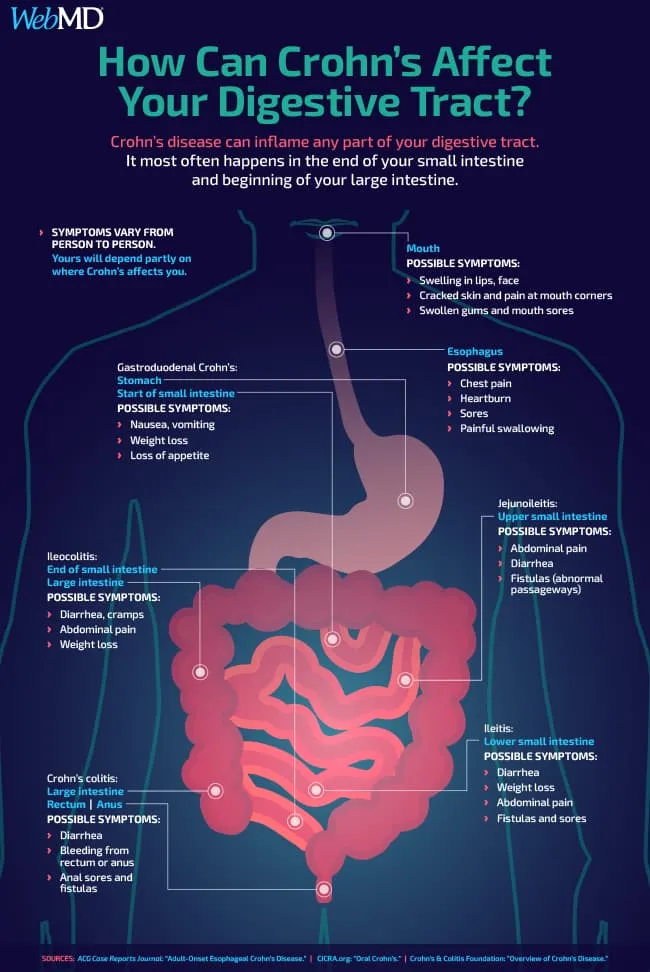
Crohn's can affect your digestive tract in patches. Some areas may be damaged while others are completely healthy.
The other main type of IBD, ulcerative colitis, affects only the colon (large intestine) and rectum. And it inflames only the inside layer of your intestinal lining. Crohn's though, can affect all layers of your intestinal wall.
Both conditions are autoimmune diseases. That means your body’s defenses go haywire and attack healthy tissue. Experts aren’t sure why this happens. In Crohn’s, your immune system mistakenly attacks the lining of your digestive tract. This leads to ongoing inflammation that brings on ulcers, thickens the intestinal wall, and eventually sets off symptoms of Crohn’s.
Not everyone with the disease has the same symptoms, common ones include:
- Frequent diarrhea
- Rectal bleeding
- An urgent need to poop
- Belly cramps and pain
- Feeling like you still need to “go” after you’ve pooped
- Constipation
Here are the parts of the GI tract that Crohn’s can take a toll on. You don’t have to put up with symptoms. Talk to your doctor about what’s going on so you can get the relief you need.
Intestine
The end of your small intestine, called the terminal ileum, and your large intestine, or colon, are the most commonly affected areas. That’s called ileocolitis. Ileitis is when Crohn’s only affects your ileum.
Both of these can bring on symptoms like:
- Diarrhea and cramps
- Pain in the middle or lower right part of your belly
- Weight loss
Jejunoileitis involves patchy areas of inflammation in the upper half of your small intestine. You may have symptoms like:
- Mild to intense belly pain and cramps after you eat
- Diarrhea
Granulomatous, also called Crohn’s colitis, only affects your colon. It can bring on symptoms like:
- Diarrhea
- Rectal bleeding
- Problems around the anus, such as abscesses, fistulas, and sores called ulcers
You’re also more likely to get skin lesions and joint pain with this type of Crohn’s.
Crohn’s in your intestine can lead to other health problems, like:
- Fistulas, infected tunnels that begin forming on the inside wall of the intestine or a nearby organ
- An abscess, a collection of infected pus, or fluid, in your lower right belly
Stomach
Gastroduodenal Crohn's disease involves inflammation in your stomach and the beginning your small intestine, or duodenum. You could get symptoms like:
- Nausea and vomiting
- No appetite
- Weight loss
Anus
This is the opening where your GI tract ends and poop leaves your body. It’s possible to have problems other than fistulas in the area around your anus. Other common issues include:
- Small tears called fissures, which can cause pain and bleeding when you go to the bathroom
- Sores called ulcers
- Infected skin
- A narrowing of your anus called anal stenosis
Esophagus
This is the tube, or food pipe, that goes from your mouth to your stomach. If Crohn’s symptoms affect it, you might have:
- Heartburn
- Regurgitation (food you ate comes back up)
- Chest pain
Some people with advanced disease also have:
- Trouble swallowing food or drinks
- Pain while swallowing
- Vomiting
- Weight loss
Mouth
When Crohn’s flares up, it’s possible to get painful sores in your mouth. Your doctor calls this aphthous stomatitis. The sores usually show up:
- Between your gums and lower lip
- Along the sides of your tongue
- On the underside of your tongue
Beyond the Digestive Tract
Some people with Crohn’s also get symptoms in body parts outside of the GI tract. Some examples are:
Joints. The disease tends to affect larger joints, which can become swollen and painful. If you get this symptom, it tends to happen when you’re having bowel symptoms.
Eyes. Up to 5% of people with Crohn’s get eye inflammation called uveitis or scleritis. The inflammation can affect one or both of your eyes. You could have symptoms like:
- Spots in your vision (floaters)
- Eye pain
- Blurry vision
- Light hurts your eyes
Skin. Some people develop bumps, sores, and rashes.

